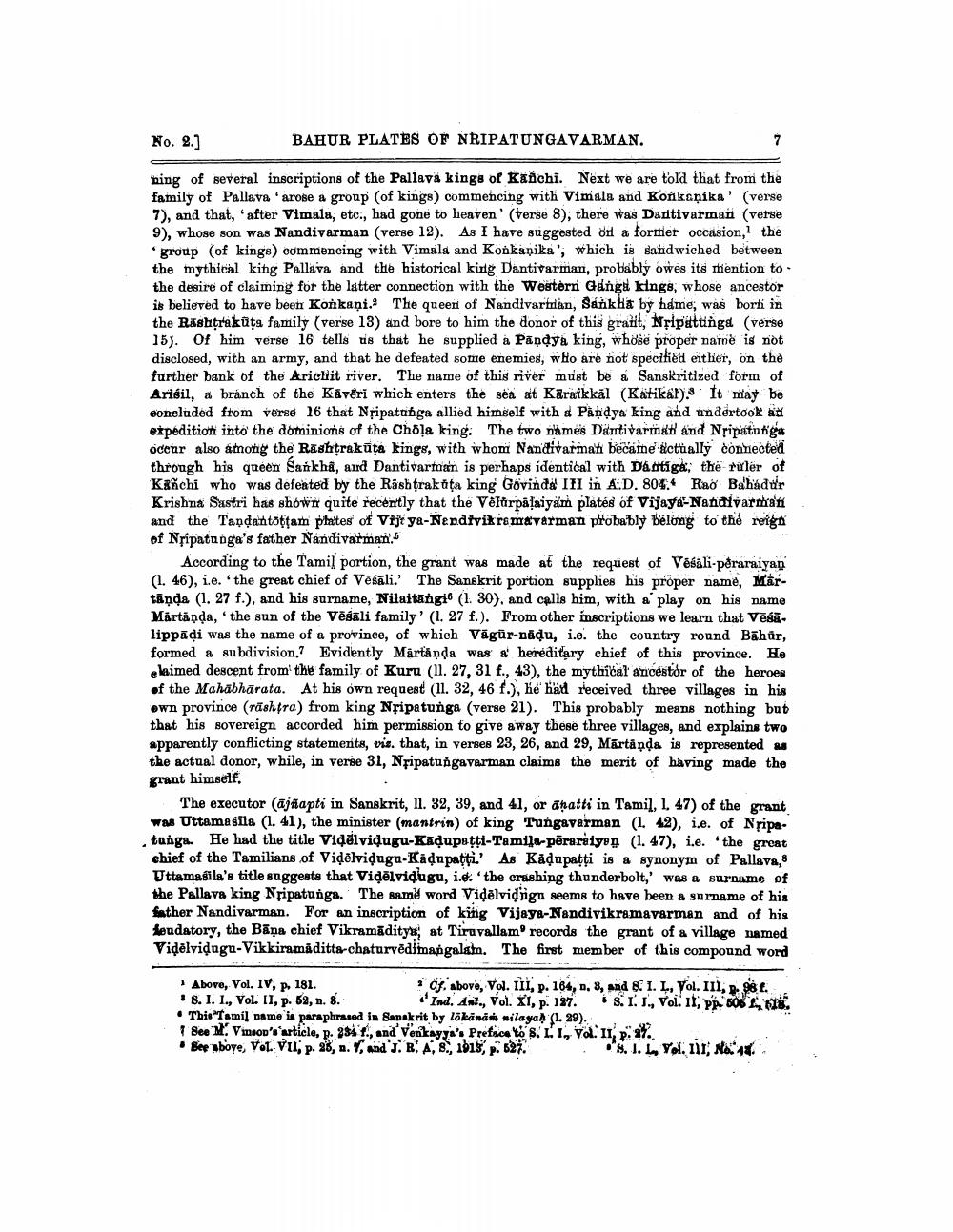________________
No. 2.)
BAHUR PLATES OF NRIPATUNGAVARMAN.
ning of several inscriptions of the Pallava kings of Kanchi. Next we are told that from the family of Pallava arose a group (of kings) commencing with Vimala and Konkoņika' (verse 7), and that, after Vimala, etc., had gone to heaven' (terse 8), there was Dantivarman (verse 9), whose son was Nandivarman (verse 12). As I have suggested on a former occasion, the group (of kings) commencing with Vimala and Konkanika', which is sandwiched between the mythical king Pallava and the historical king Dantitarman, probably owes its mention to the desire of claiming for the latter connection with the Western Ganga kings, whose ancestor is believed to have been Konkaņi. The queeri of Nandivartan, Sáňkha by name, was borti in the Rashtrakūta family (verse 13) and bore to him the donor of this gratit, Nripätunga (verse 15). Of him verse 16 tells us that he supplied a Pāņdya king, whose proper name is not disclosed, with an army, and that he defeated some enemies, who are not specified either, on the further bank of the Arichit river. The name of this river must be a Sanskritized form of Artsil, a branch of the Kávēri which enters the sea at Kāraikkal (Katikat). It may be concluded from verse 16 that Nřipatunga allied himself with a Pâtidya king and undertook a expedition into the dominions of the Chola king. The two námes Dantivarmat and Nripatuñiga odeur also among the Rashtrakūta kings, with whom Nanditarmat becaine Éctually connected through his queen Sankhâ, and Dantivarman is perhaps identical with Dantiga, the ruler of Kanchi who was defeated by the Rashtrakota king Govinda III in A.D. 804.* Rao Bahadur Krishna Sastri has shown quite recently that the Vélirpaļaiyam platés of Vijaya-Nandivartha'ni and the Tandantottam plates of Vijt ya-Nepdivikremavarman probably belong to the reign of Nrípatunga's father Nandivatman.
According to the Tamil portion, the grant was made at the request of Vēšali-pèraraiyan (1. 46), i.e. the great chief of Vēsāli.' The Sanskrit portion supplies his proper name, Märtanda (1. 27 f.), and his surname, Nilaitāngi (1. 30), and cells him, with a play on his name Märtända, the sun of the Vēgali family' (1. 27 f.). From other inscriptions we learn that Vēšā. lippādi was the name of a province, of which Vāgür-nádu, i.e. the country round Bāhär, formed a subdivision. Evidently Mártanda was a hereditary chief of this province. He elaimed descent from the family of Kuru (11. 27, 31 f., 43), the mythical ancestor of the heroes of the Mahabharata. At his own request (11. 32, 46 f.), he had received three villages in his own province (röshtra) from king Nřipatunga (verse 21). This probably means nothing but that his sovereign accorded him permission to give away these three villages, and explains two apparently conflicting statements, vis. that, in verses 23, 26, and 29, Mārtanda is represented as the actual donor, while, in verse 31, Nripatungavarman claims the merit of having made the grant himself
The executor (ājnapti in Sanskrit, 11. 32, 39, and 41, or anatti in Tamil, 1. 47) of the grant was Uttamasila (1. 41), the minister (mantrin) of king Tungavarman (1. 42), i.e. of Nřipatanga. He had the title Vidéividugu-Kadupetti-Tamila-pērarsiyen (1. 47), i.e. the great chief of the Tamilians of Vidēlviņugu-Kadupatti.' As Kādupatti is a synonym of Pallava, Uttamasila's title suggests that Vidēlvidugu, i.et. 'the crashing thunderbolt,' was a surname of the Pallava king Nřipatunga. The same word Vidēlvidiga seems to have been a surname of his father Nandivarman. For an inscription of king Vijaya-Nandivikramavarman and of his feudatory, the Bāņa chief Vikramădity at Tiruvallam records the grant of a village named Vidēlvidagu-Vikkiramăditta chaturvedimangalam. The first member of this compound word
Above, Vol. IV, p. 181.
* cf. above, Vol. III, p. 164, 6, 8, and 61. L, Yol. III, 98 t. . 8. 1. 1., Vol. II, p. 62, n. 8.
Ind. Amt., Vol. II, p. 187. SI J., Vol. it, PP. 508, 18. • Thiu Tamil name is paraphrased in Sanskrit by lökänai wilaya) (1. 29).
See M. Vmood's 'article, p. 381 7., and Venkayga's Preface to S. L'I, Vol. 11, pat • Bep above, Vol Vu, p. 25, n. 1, and J. BA, 8., 1013, p. 6277
$. I. , Vol. , N 44.




